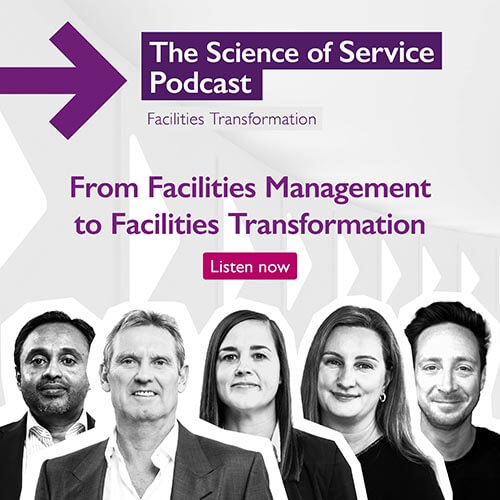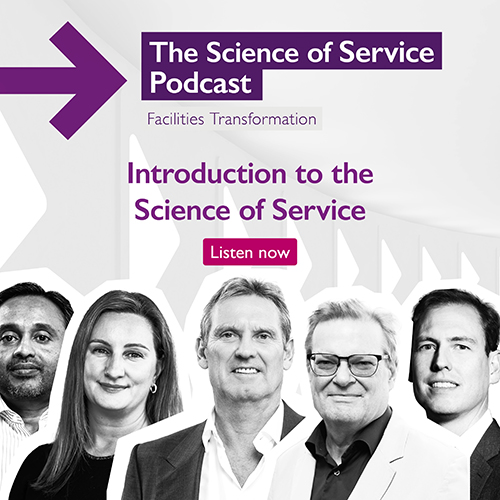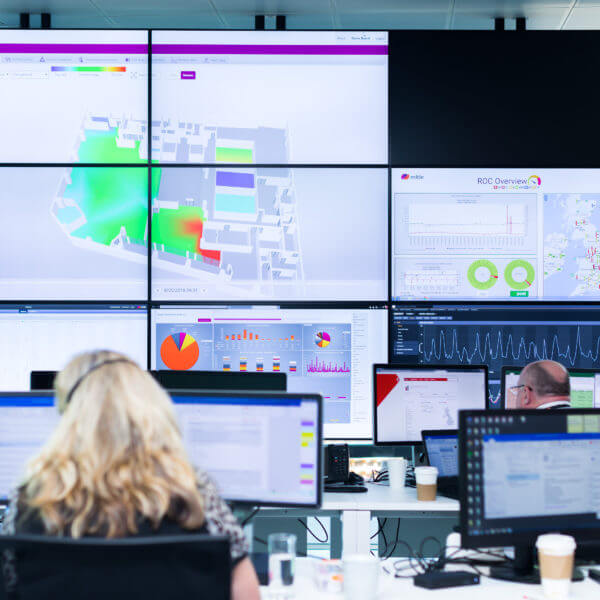The Science of Service Podcast: The golden opportunity of ‘black box’ tech

By Ian Ellison, Workplace Geeks
Listen to episode six now: From facilities management to facilities transformation
As we approach the end of the podcast series, Chris and I are in a reflective mood. If The Science of Service is the banner to showcase Mitie’s drive towards facilities transformation, what have we learnt? What are the implications for the future? What parts of our adventure have stood out the most?
A lot has happened in the world since the start of the project. Geopolitical dynamics have changed, economic and climate pressures continue to mount, the hybrid working debate is now firmly post-pandemic and digital technology advances at pace.
Generative opportunities
When we began planning the series, awareness about generative AI was beginning to ripple outwards from Silicon Valley. Some critics flagged the risks of putting faith in technology whose ‘black box’ functionality – its mysterious ways of working – can only ever be partially understood. Yet advocates broadcast AI’s benefits for many facets of modern life, including work, education and healthcare. While this debate continues, it seems like most progressive organisations are either already using AI or exploring its uses. Before the pandemic drew attention elsewhere, business concerns centred around the impacts of automating operational work. So, while the advances in generative AI began many years ago, the current focus has shifted to include even more complex managerial tasks. Is this exciting? Or of concern?
On location with Mitie
Episode six of The Science of Service Podcast, presented by me, Ian Ellison, and my Workplace Geeks co-host, Chris Moriarty, begins by revisiting some of our favourite Mitie client sites. We’ve seen the sustainable technology of ground source heat pumps deployed on an epic scale at Lloyds Banking Group’s Halifax headquarters building. We’ve witnessed security data fuelling Real Estate Management UK’s control centre intelligence deep in the heart of London landmark, The Shard. We’ve learnt how the app-based ability to order a barista-brewed coffee, piping hot with a personal touch, has transformed workplace experience at Royal London. We’ve heard how smart work management applications at John Radcliffe Hospital, Oxford, have made a difference to both patient experience and health outcomes. And yes Chris, just for you, we’ve finally met those shiny Mitie robots.
Tech + people = not just different, but better
But robots, in all honesty, are just the tip of the technology iceberg when it comes to Mitie’s future aspirations. Perhaps it’s all that humanoid-heavy clipart on social media skewing perceptions. Because it’s actually data – and our increasingly sophisticated analytical computing power to drive insights from it – that is the real transformative hero here. This runs through the ‘digital plumbing’ described by Mitie’s Chief Technology and Information Officer, Cijo Joseph. Echoing this sentiment, Mitie’s Data Director, Dan Blake, reminds us that it isn’t only generative AI that will transform workplaces. It’s AI combined with vast quantities of often unstructured data and computational power.
If there’s one recurring theme we’ve seen in every episode of The Science of Service Podcast, it’s that technology + people = not just different, but better. There’s one piece of clipart that gets this just right – Michelangelo’s The Creation of Adam, where one of the hands now belongs to a robot. It says a lot. As pointed out by Mitie’s Chief Marketing Officer, Maria Winn, we need both machines and humans for the foreseeable future.
Rhetoric or reality?
But what does this mean for the vast FM sector workforce? Will they embrace this transformational change? Mitie’s Chief People Officer, Jasmine Hudson, views the situation optimistically; it’s one rich with learning and development opportunities. At the helm of a technology-backed workforce, Jasmine stands firmly committed to a team-focused, values-based workplace.
I wondered out loud, in my first blog, whether ‘The Science of Service’ was clever facilities management rhetoric or a true reflection of the sector’s transformation. To conclude the series let’s defer to Mitie CEO, Phil Bentley: “I think ‘science’ and ‘service’ was a good juxtaposition of two words that don’t always go together, but really captured in our imagination what it is we were trying to do.”
And do you know what? I think they really have.

From facilities management to facilities transformation
It’s the end of Chris and Ian’s facilities transformation adventure. In the sixth episode of the podcast, they reflect on what they’ve learned along the way. Their personal highlights include visits to Mitie’s customer sites, where they witnessed technology’s impact on Facilities Management (FM) firsthand. They conclude data and AI will only disrupt and drive the sector’s transformation further, bringing technology-backed benefits to a brave new customer-focused world that can’t be imagined right now.
On a return visit to The Shard, they chat to Mitie CEO, Phil Bentley, who is excited about the role of data, tech and AI in FM’s future. When delivered hand-in-hand with dedicated people and well-managed places, organisations will be more efficient, smart and agile enough to cope with today’s fast-moving landscape.
-
 Phil BentleyCEO, Mitie
Phil BentleyCEO, Mitie -
 Cijo JosephChief Technology and Information Officer, Mitie
Cijo JosephChief Technology and Information Officer, Mitie -
 Maria WinnChief Marketing Officer, Mitie
Maria WinnChief Marketing Officer, Mitie -
 Dan BlakeData Director, Mitie
Dan BlakeData Director, Mitie -
 Jasmine HudsonChief People Officer, Mitie
Jasmine HudsonChief People Officer, Mitie
It’s the end of Chris and Ian’s facilities transformation adventure. In the sixth episode of the podcast, they reflect on what they’ve learned along the way. Their personal highlights include visits to Mitie’s customer sites, where they witnessed technology’s impact on Facilities Management (FM) firsthand. They conclude data and AI will only disrupt and drive the sector’s transformation further, bringing technology-backed benefits to a brave new customer-focused world that can’t be imagined right now.
On a return visit to The Shard, they chat to Mitie CEO, Phil Bentley, who is excited about the role of data, tech and AI in FM’s future. When delivered hand-in-hand with dedicated people and well-managed places, organisations will be more efficient, smart and agile enough to cope with today’s fast-moving landscape.
“I think ‘science’ and ‘service’ was a juxtaposition of two words that don’t always go together but captured what it is we were trying to do. We’ve seen an acceleration, definitely of the science, and the service goes alongside that.”
Phil Bentley, CEO, Mitie
Episode links
Accelerating Facilities Transformation white paper
The Science of Service (video)
Watch now: From facilities management to facilities transformation
Episode 6: From Facilities Management to Facilities Transformation
Speakers:
Chris Moriarty
Ian Ellison
Matteo Deidda
Andrew Donaldson
Peter Henderson
Diane (Nurse)
Cijo Joseph
Dan Blake
Jasmine Hudson
Maria Winn
Phil Bentley
Episode 6: From facilities management to facilities transformation
Speakers:
Chris Moriarty: Technology. For millennia, humans have developed tools to make life easier, better. With each passing generation, our knowledge improves and the tools we create become more and more sophisticated. And each of these developments create the conditions that lead to the next wave of technological advancements.
It was technology that enabled the earliest communities to visit other parts of the world to learn more and share their knowledge. It was new scientific instruments that have allowed teams to study the world around us at greater depth – and use that to inspire change. And given the close relationship between technology and resources, this path has always had a tight relationship with economic development work.
The printing press, steam engines, lightbulbs, telephones, personal computers, the internet. All important technological leaps in their own rights, but they’ve also gone on to not only transform how we do specific tasks, but change behaviours and attitudes. Their ripples can be felt in every corner of society for generations.
And today we see the rate of technological development accelerate. A professor at Oxford University recently pointed out that it took 2.4 million years for our ancestors to control fire and use it for cooking, but only 66 to go from the first flight to landing on the moon. And AI appears to be the poster child of recent technological developments. It’s never been easier to capture data, but it’s far trickier to make sense of it and turn it into the actionable insights that we need to make better decisions, to power processes, to make meaningful change.
But with AI computing now becoming mainstream, that computing power is no longer locked up in the lab. It’s accessible on most people’s laptops. And as organisations start to explore this technology explosion, they start to consider the generational changes that we can make as we face increasing challenges: climate change, heightened security, new ways of working, new approaches to health, all of them benefitting from cutting-edge technology.
But all the while humans are there to steer it, combining their expertise, their emotional intelligence, their experience with the powerful processing capabilities that technology provides. It’s this relationship that we’ve explored in this series of podcast episodes. It’s this fusion of science, technology, and human endeavour that has peppered our stories from some of the UK’s leading organisations. And in this final episode of the series, we explore what we’ve seen and what we’re going to see in the future. This is the story of Mitie, an organisation leading that charge. This is The Science of Service.
Hello, and welcome to the final episode of this mini-series of The Science of Service Facilities Transformation Podcast. My name’s Chris Moriarty.
Ian Ellison: And I’m Ian Ellison.
Chris Moriarty: And we’re the hosts of the Workplace Geeks podcast, but have been here hosting this one for Mitie following an invitation from their CEO, Phil Bentley, to explore The Science of Service: a range of new tools, new services, new science that is transforming facilities, transforming organisations – and it’s fair to say, in some cases, transforming lives.
Now, in this episode, we’re reflecting on what we’ve seen in the previous four deep dives into the world of climate, security, workplace and health. So, if you’ve joined us here, having not listened to those, it might be worth your heading back there now.
But if you’ve been with us the whole way, well, firstly, thank you for joining us, but we’re also going to have a quick reflect on what we’ve seen, catch up with the Mitie leadership, as well as speak to a few new voices about some of the topics that have come out of our collection of stories. So, Ian, have you enjoyed our little voyage of discovery?
Ian Ellison: I have indeed. It’s one thing to sit in a studio and talk conceptually about some of these ideas, but the opportunity to speak directly to the teams putting these ideas into action, and even get to visit them on site – it was truly special.
Chris Moriarty: Agreed. So go on then, pick out a few highlights from the Mitie clients that we’ve been lucky enough to go behind the scenes with and why you thought they were so important.
Ian Ellison: Well, I only got to go on one field trip, but the opportunity to venture deep underground in Halifax with Lloyd’s Banking Group was a really special moment for me.
Chris Moriarty: So, this is where you join Matteo, who leads Lloyd’s Banking Group’s net zero work, and he took you deep underground to look at a heating system under one of their HQ buildings. So, here’s Matteo and Ian in a hole as deep as The Shard is high, and Ian got to take a look at Matteo’s…
Matteo Deidda: boreholes. From one borehole we extract and from the other borehole we re-inject it. So, what we do is this temperature stay, let’s say, at 12 degrees during the year. So, during the summer, outside is 30 degrees, we take this water, we use it to kick off the cooling of the building.
Ian Ellison: So in layman’s terms, ground source heat pump technology takes the edges off at both extremes. It gets you up, when it’s cold. You’re down when it’s hot.
Matteo Deidda: So, this building is like an iceberg.
Ian Ellison: Yeah, it’s like an empire. This is like a journey to the depths of the unknown. It’s brilliant.
What was so interesting about that was not only was this an impressive project in its own right, making one of their oldest buildings more sustainable – given all that we hear about the difficulty in retrofitting sustainable solutions to existing property – but also how it was having a ripple effect across the town in terms of feasibility and knowledge sharing.
Projects like these are still so groundbreaking. In this case, quite literally. If we can use that to spin up other opportunities, then this can only be a great thing for the future.
Chris Moriarty: Now, one of my standout moments was when I got to pretend I was in the Secret Service. Well, sort of. At least I felt like I was in a…
Like some sort of Bond movie. I mean, so, so we’re looking at two dozen different screens. I guess they rotate and can be reconfigured to whatever you need to look at. There’s a team in there, with lots of monitors.
So, one of my best moments was when I got invited into the belly of The Shard to take a look at their security operation. Now this is somewhere that very few members of the public get to go to, for good reason. But when you’re there, in the epicentre, you get such a clear view of the sophistication of the operation. In a building that I’ve been in dozens of times, by the way, it’s epic really what goes on around us to keep us safe.
There seems to be like, there’s lots of lights and data. So this is, I mean, it’s very little that can go on in this building that you can’t. Yeah. Be monitoring, right?
Andrew Donaldson: That’s it. And we have this divide in there as well, and that’s for a command team not to get in the way of an operational response. So, I’m one of the few senior leaders within the organisation that can actually access the control room when I need to. Everybody else involved in our gold, silver, bronze structure – that’s the framework that we respond to incidents for – they stay in here. So they do not get in the way of the guys and girls who work in there of getting their job done. And that’s dealing with whatever incident it is. Everything’s duplicated in here so we can have that live feed put specifically into this room for the command team.
Ian Ellison: I’m amazed they let you in there. I’m even more amazed you didn’t press something that you shouldn’t have.
Chris Moriarty: I’m even more amazed than you. In fairness, Andrew was keeping me on a short leash and making sure that I couldn’t mess anything up. What was remarkable about that visit is that it wasn’t just the hardware that was impressive, but the sheer amount of data that was pinging around between different bits of kit, as well as the feed-in from Mitie’s security hub. It’s huge and it’s a great example of volumes of data needed in operations like that, and why technology to help us prioritise and make sense of it is crucial so that we can make better decisions.
Ian Ellison: Talking of remarkable, do you remember how excited you got about coffee ordering at Royal London?
Chris Moriarty: I know, I probably asked too many questions about that.
Peter Henderson: Some people are very organised, don’t have time for a stop and a chat, need their caffeine hit. They’re up at God knows when in the morning. They just leave the house, they don’t have a coffee. So, what we have here is an online system where, if you are of that mindset, you were someone who liked to order your coffee, uh, and needed that hit. You can do it using the app. You’re able to select the location and the time that you want your coffee to be, or it doesn’t have to be coffee.
Chris Moriarty: Well, but that’s even, you’re saying about the location, that’s even before you’ve got here. So it’s not like once you’re in. So if I’ve come up at Liverpool Street and I’m looking at it and going right, I’ve got about 10 minutes before I’ll be in the office, so I’m going to walk there. I’ll pre-order that so it’s there waiting for me when I arrive.
Peter Henderson: Absolutely. So I don’t have to spend that time queuing, that you’d normally have to do first thing in the morning.
Chris Moriarty: So thank you to Mitie’s Peter Henderson for giving me the show round there and putting up with my obsession with coffee. But remember Ian, it wasn’t just about how it makes things more convenient. It was also about how those little moments like that are helping to build a broader data picture that allows Royal London and Mitie to work together to make more informed decisions about the future workspace provision. Data that was not previously there.
Peter Henderson: So, you can start understanding your peaks and troughs as they’re coming through. And then if we want the trial stuff again, that provides the data that backs up a trial. So that if we need to put a business case together, we go, well, hang on, we’ve been harvesting a bit of data. This is the business case combined with some observations that we’ve had as well from the industry and some insights. And it gives, it gives our client confidence to go, yeah, do that. Let’s, let’s give it a go, let’s see how it goes. As opposed to someone just going with their gut. Sensors under every workstation, and some of our touchdown spaces, and in every meeting room, so that we can understand, how is our workspace being used. And that data helps us to drive decision making around, well, that neighborhood, does it need to be that size? Because that team only comes in on a Monday and Tuesday, and they’re finding difficulty finding desks on a Tuesday. But perhaps that neighbourhood can be changed and we can do it on a Thursday and Friday. And we would have those conversations with our customer based on the data that comes back from their sensor for utilisation.
Ian Ellison: And the standout moment in our final deep dive at John Radcliffe Hospital was when you bumped into the nurse on the emergency ward who was raving about a relatively simple but effective piece of technology that the Mitie team had installed.
Chris Moriarty: You mean Diane?
Diane: This is the best thing since they’ve come. It’s absolutely brilliant.
Chris Moriarty: What difference does something like this make in real terms?
Diane: A big difference. It helps the flow from ED onto us a lot quicker because we’re able to order the beds. Discharge is a lot quicker, so it makes a massive difference. And I guess there’s a lot
Chris Moriarty: And I guess there’s a lot of, in the past, when everything was very manual, a lot of lost time? Something doesn’t turn up, you can’t track it, you don’t know if someone’s…You know, with all of this, it’s kind of all been tracked at every stage.
Diane: Yeah, looking for the domestics, we don’t have to anymore. We just literally go there, book the discharge, they’re on the job.
Chris Moriarty: That really was the best example of the impact that this stuff is making.
Ian Ellison: And it was the episode where you finally got to see some robots in action.
Chris Moriarty: Why do you say it like that? It wasn’t like that was the only thing I was excited about.
Ian Ellison: The robots. Huge army of robots and drones.
Chris Moriarty: The drones. The robots. The AI.
Ian Ellison: The robots. Robots. Distracted by robots.
Chris Moriarty: You had the robot.
Ian Ellison: Robots, service ordering apps and data.
Chris Moriarty: We’ve seen robots. Did you ask him about robots?
Okay, so maybe we did do what a lot of people do and got excited about robots when we start talking about things like new technology, but I think what we’ve seen in this series is that whilst there are robotics involved, they are probably the most visual innovation, but below the surface there is powerful technology powering everything.
Ian Ellison: Ah yes, digital plumbing. That reminds me of the conversation we had with Cijo Joseph, Mitie’s Chief Technology and Information Officer all the way back in episode one. And perhaps it’s worth heading back to him first, as we go back to The Shard to chat with the Mitie leadership team. And it feels like the starting point is all of this data we’ve seen collected at our different client examples and how we make sense of it moving forwards.
Cijo Joseph: So we have got data, which is structured, which means all your IT systems, which have got a proper structure of storing your data, like your asset information, your job information. Then you have got this unstructured data, which is like the engineer writing up some log notes, or you’re typing a Word document saying that this is what I saw in client XYZ.
What we’ve done is we’ve brought the structured data and unstructured data together in our cloud-enabled data lake. So, we brought these two together. Just as a volume perspective, if you look at it, it’s roughly around 800 terabytes of data, which is near to one petabyte, which is around, if you look at the real world translation of that, that’s around 20 million tall filing cabinets of information.
Now, if you ask a human, this is all the data you have got. Go and interpret what does it say? It’s not humanly possible. I’m saying human, humanly possible to do anything about it. So, what we are doing with the technology is, that’s where the technology comes in. That’s where the AI comes in. That’s where the cloud enablement comes in – where it goes and crunches all these things and gives you insights and information at your fingertips. And that’s the value add. AI is becoming mainstream for everything what we do. Whether we, the way we look at the assets, the way we look at the energy reduction, the way we look at remote monitoring, the way we look at even the conversation engine, which I’m talking about. But it’s all leading to help the humans who are the experts to work on it, and then fulfil the needs of our customers.
Ian Ellison: Now, AI has been something that’s come up a few times, and I think it’s fair to say that during the recording of this series over the past few months, the sheer volume of products with AI capability and the general attention on AI technology has reached quite a crescendo. So, I spoke to Dan Blake, Mitie’s Data Director, who is their resident expert on these types of things.
Dan Blake: When we’re talking about AI within the public discourse at the moment, what people typically mean is large language models, is GPT, generative AI. And the reason I think that’s important in the context of this discussion is that that’s brought an immediacy of what were previously algorithms sat in the background, you know, that have been around for a long time. It’s brought an immediacy to the power of AI, because people can see from a text prompt what can be achieved – made it really tangible and real for people. And that creates both challenges, but opportunities, you know, the volume of discourse in the C-suite across the whole of UK PLC after ChatGPT has been substantial.
Chris Moriarty: So, Dan is saying things like ChatGPT has had such an impact on general discourse that business leaders are focusing on what their strategy is for AI in the future.
Ian Ellison: Yeah, but Dan makes it clear that whilst this has helped raise the profile of the technology, it’s not specifically things like ChatGPT that we’re going to start seeing popping up in our offices.
Dan Blake: We’ve got two real trends, megatrends here, that are quite different, I think, and impact my world in particular in two different ways. You’ve got generative AI, so large language models, and what they can do to large corpuses of unstructured data. But the other trend, and I don’t think you can really decouple these, is the adoption by corporates, and we are very much at the forefront of this, of large mass storage and compute technology.
So, you know, for us at Mitie, that’s our data lake. What that’s meant is that for companies who have made that step, they have a large, established data storage layer with data ready to mine with AI and machine learning tools, and I think it’s really important to look at those two trends connected to one another, because the growth of mass storage, mass compute has effectively created the pitch that we all play on. And while these technologies have become much easier to deploy, what’s really, really key is that in order to do that, you need the data footprint to deploy them on. Now we’ve got 60, 000 people in buildings, in UK built environment, and that gives us some really unique insights into how those buildings are operating, what’s driving cost, what’s driving investment and maintenance trade-offs, what’s driving commute-worthy spaces, utilisation, and you need to look at those. I suppose what I’m saying is you need to look at those two things in tandem, really.
Ian Ellison: So, there’s the front end, for want of a better phrase, that your average person would engage with. But what Dan is saying here is that the potential of a corporate enterprise level is huge because of the vast amounts of data that is collected all the time. AI now allows us to make sense of that complex, often unstructured data at speed and in ways previously unimaginable.
Chris Moriarty: So, does this get us back to what Antony Slumbers said in episode one about smart buildings that will self report, self maintain? Will we no longer need humans in all of this?
Ian Ellison: Dan isn’t saying that, but it does start to take us towards a conversation about what work will look like for humans in the future, particularly as machines start to take over the more repeatable, predictable, analytical roles in the future to compliment what we’re doing. Remember the research we spoke about in the first episode that we wrote back in 2018? Well, we suspect that this sector in particular is something where we’re very likely to see that unfolding. But what Dan is talking about is what opportunities these data lakes provide us, and how we can combine that with our decision making.
Dan Blake: So within our data lake, we have, you know, a significant amount of computational power that we can use to process this data and that increase our knowledge about the data that we’re looking at. And by increasing that knowledge, we can then drive automation from that. So, there’s a whole play in there around process efficiency. And I don’t think FM is unique in that. I think we’ll see that across all of UK PLC. Different organisations will adopt it more quickly than others. You know, predictive maintenance has been talked about for decades.
What I think we’re seeing now is, with a footprint of data like we have at Mitie, with the ability to execute these kind of machine learning algorithms across that data quite rapidly, that becomes a much simpler, more achievable outcome. Combination of human decision making with much more mineable analytically-based data sets is where this really starts to sing.
Chris Moriarty: So, I guess that’s a nice lead off into the next big theme alongside things like AI that we saw coming up from our various conversations in this series – the role of the human. Now, we’ve heard a number of times that rather than replace human labour, which is often cited as a concern about technological development, instead, we will see people take on different roles as the machines pick up the repeatable predictable stuff, like you said, Ian. So remember in our episode about cleaning, the robots did 99 percent of the cleaning on the floor space, leaving the humans to do the tricky but critically important corners and edges?
It was the same with the security episode. Technology might be helping you detect threats, but it’s the human that is deciding how to proceed, how to respond to those threats. So, what does that mean for the workforce of the future? And how does an organisation like Mitie, with a huge workforce, prepare their people for that shift? To help me find out, I caught up with…
Jasmine Hudson: I’m Jasmine Hudson. I am Chief People Officer at Mitie, and that essentially means I look after everything in the people space. So Reward, Learning and Development, Diversity and Inclusion, Culture – all of the things you’d expect to see in my remit. We have 65,000 colleagues, 45,000 are frontline cleaners, security guards, porters, receptionists. So our customer-facing roles. There’s probably another 10,000 behind the scenes. So, operating the TSOC, the operating centre, and all of the functions that sit behind them as the leadership structure.
Chris Moriarty: That’s a huge workforce by anyone’s standards and a wide range of roles and seniority. So what does that look like in the context of new technology from a learning and development perspective?
Jasmine Hudson: Deploying technology at pace and we’re expecting a lot of our people to use technology in their day to day. So we have to give them the training to operate that technology to do a better job. We have acquired a load of businesses and they come with different skills needs and they come with different bought-in skills development courses.
So we look at cyber, data intelligence, we look at MBAs, Masters, training. So we’re trying to skill people and re-skill people and re-train people to have this higher level of capability. But we also partner major people like Vodafone, Microsoft, that come in and give our people training to, to be able to manipulate our data, to give the insights we need to be a better organisation.
We also partner Royal Holloway. So, in the IT space, where we’re looking at technology and data and insights, we partnered Royal Holloway to bring in some of their grads to work with us. But equally we go out and we train some of their people and deliver on their courses. So it’s multifaceted. I think as we go forward and we deploy more and more technology, we’re going to have to think about how we attract from the outside in. And we’ve got some excellent people that we’ve brought into the organisation in recent times, but it’s always going to be a cross fertilisation of existing Mitie people that grow, and new people bringing the outside-in perspective.
Ian Ellison: So are we seeing roles change then?
Chris Moriarty: I didn’t get that impression. Sure, some of them might, but this feels more like responsibilities remain fairly recognisable, but the technology means, the how we do that evolves. Jasmine put it like this…
Jasmine Hudson: Not that we’re changing job descriptions as yet. I think what we’re looking at is output-based delivery. So we, you know, the job remains the same, they’re just doing it a different way. So instead of doing it themselves, they’re operating the machinery. And it’s not like some of these robots can just come out and run themselves. They have to have a person that works with them, that shows them the route map, that turns them on, turns them off, refills them, all of those bits. So, it’s really about people working with technology to deliver better outcomes for our customers. If you meet Mitie people, they have a certain je ne sais quoi about them. They’re very unique people that go the extra mile time and time again. And when we survey our people and ask them what they love about working at Mitie the most, it is working with their colleagues. So, it is an environment in which the Mitie values come to life. And actually technology is making their lives better.
Ian Ellison: That’s interesting. So not only have we seen examples of how technology is improving services, transforming products, or reshaping delivery, but in this example, Jasmine is talking about how Mitie staff are also benefitting.
Chris Moriarty: Exactly. We touched on it before in the cleaning episode, when we spoke about the sheer volume of floor space that an operative was expected to clean. But now the robot will do most of that heavy lifting. So there you go. Everyone is a winner on this front.
Ian Ellison: We’re coming towards the end of our journey of discovery. And it only feels right that we pop back to the very first people we spoke to. Maria Winn, Chief Marketing Officer, who is looking at how all of this is reshaping the service propositions that Mitie bring to their clients. Cijo Joseph again, and of course, CEO, Phil Bentley himself, as we consider what the future looks like. So, let’s go to Maria first. Given all that we’ve seen, where does she see it going? What’s coming next?
Maria Winn: If I sort of reflect where we’re up to right now, example being robots in hospitals, right? So those robots will clean on a defined algorithm, a defined path. What that human-robot partnership, what that means is that at the moment, the robotics are doing the scheduled, uncomplex, freeing up the human teams to work on things that happen impromptu. Sort of the more reactionary things and complex things, where robots can’t potentially understand. And I think that’s where we are right now. What we’re starting to see creep in now, and again I’ll use the example of robotics and cleaners, if we think about AI and computers, we’re using some technology called Spill Detect. Which uses the camera to say, okay, we’ve had a spill here. Identify it on the floor. I guess what the robots now need to do is to be reactive to that and to bring those two together.
What we’ll see robots doing is being able to do more of that reactionary complex task work. Where I’m not seeing us over the next three or five years is them replacing the relationship element and the face-to-face part of what we do. For many of our clients the Mitie staff, perhaps on the front desk reception, might be the first impression that people have of that organisation. I don’t think we’re there with, with robotics, with AI, with computers to replicate that human interaction in that same way. And we are seeing automated reception desks. But for many of our clients, that warmth of greeting and that human element is still really important.
Chris Moriarty: And that’s something that Phil Bentley, CEO of Mitie, echoed when we sat down with him for one last chat on this podcast. Take it away, Phil.
Phil Bentley: Well, there’ll always be people involved, we would certainly hope, because, you know, we’re in a people business at the end of the day. People are making the experience what it really is.
Chris Moriarty: Now, it would appear that since we sat down and spoke with Phil, they’ve been quite busy laying the foundations for the next phase of this work.
Phil Bentley: Since we spoke, we’ve bought a big engineering company that does a lot of high-tech energy work in data centres called JCA. We’ve bought a battery energy storage that’s fitted over the UK’s industrial battery storage and battery storage is used and needed if you can’t get that grid connection back. We’ve bought businesses specialising in intelligence security, in terms of a business that is an expert in perimeter hardening. The business that does high-tech fire and security systems. Fire and security systems and building management systems are converging on the same platforms today because it’s all data, it’s all data. And we’ve got a few more of those up our sleeve. So yeah, no, we’re certainly putting our money where our mouth is.
Ian Ellison: And it’s not just about investment, Cijo also mentioned partnerships when we spoke with him.
Cijo Joseph: I always say, make use of what you have got out there. There’s quite a rich set of algorithms out there. Quite a lot of rich set. We are doing a go-to-market proposition with Salesforce. They are rolling out quite a lot of rich AI algorithms into their net zero carbon proposition.
We don’t need to create one. We just consume it based on our data we have got. We apply those into the data set and we get the end result. We are doing a massive AI co-pilot, Microsoft AI co-pilot. Three hundred top accounts and sales team are actively using it. Now what are they using? They’re consuming the AI and applying it to their day to day task. You don’t need to recruit lots of data scientists, but you need to navigate and help the consumers to understand how to apply that.
Chris Moriarty: So, I think we’re approaching last word territory here.
Ian Ellison: I’d say so. So Chris, where do you think we should end this podcast series then?
Chris Moriarty: Well, I’ve always thought how interesting the combination of science and service was. Something that on the surface looks like a catchy title, but what we’ve seen over the past few episodes is how perfectly it encapsulates the relationship between the two parts of the equation – the human and the machine. Like a yin and yang, a perfectly symbiotic relationship. So I asked Phil about that in what will be the final word of this mini-series.
Phil Bentley: I think ‘science’ and ‘service’ was a good sort of juxtaposition of two words that don’t always go together, but really sort of captured in our imagination what it is we were trying to do. We’ve seen an acceleration definitely of the science, and the service goes alongside that.
In the old days, property was the sort of facilities, it was the domain of the property manager or it was the domain of the procurement manager. But increasingly we’re dealing with clients now who, who in their title is often ‘people and places’. We’ve got clients now who say, ‘I’m Chief People and Places Officer.’ And what that recognises is that the built environment is incredibly important to the culture that the clients are trying to create or to change. And so how do we help them on a cultural transformation, where their people feel value and want to come to work?
Chris Moriarty: So we have come full circle. We opened this series with a conversation with Phil about this rarely noticed but hugely important sector making some significant breakthroughs against some of the starkest challenges we face. And it’s doing that with groundbreaking technology and decades of human experience.
Ian Ellison: And as you said at the beginning of this episode, the technology at our disposal is only going to improve, and quickly. So there’s tonnes more to look forward to with The Science of Service.
Chris Moriarty: So there you have it. Thank you to everyone who’s listened. Thank you to everyone who’s contributed. And thank you Ian for putting up with me talking about robots.
Ian Ellison: You are most welcome.
The Science of Service Podcast has been a Workplace Geeks production for Mitie. With us, Ian Ellison and Chris Moriarty. You can find our regular show, Workplace Geeks, wherever you get your podcasts. If you’ve enjoyed the show, please rate and review it and please share with others. It really helps spread the word.
Now, loads of people were involved in the making of The Science of Service, and we want to say thank you to them all. In particular, David Crackles, who was our dialogue editor for the project and the production team from Mitie, including Claire Johnson, David Lowe and Tina Hobart.
Thank you to the following guests in episode one: Jeffrey Saunders, Antony Slumbers, Phil Bentley, Maria Winn and Cijo Joseph.
In episode two: Eleni Polychroniadou, Matteo Deidda, Ben Finlayson, Catherine Wheatley and Prad Pandit.
In episode three: Alison Wakefield, Andrew Donaldson, Matt Rogers, Emma Shaw and Jason Towse.
In episode four: Perry Timms, Simone Fenton-Jarvis, Leigh Fyffe, Peter Henderson, Simi Gandhi-Whitaker, Richard Anderson and Mark Caskey.
In episode five: John Lear, Derrick Andrews, Andrew Sharp, Heather Downes, Jacinto Jesus and Alice Woodwark.
And finally, in episode six: Jasmine Hudson, Dan Blake, and once again, Maria Winn, Cijo Joseph and Phil Bentley.
Read next

The Science of Service Podcast: Invitation to a brave new world
Back in the 1990s, chess grandmaster, Garry Kasparov, faced IBM’s Deep Blue computer. It was the classic battle of strategic skill. But with a twist. This time, the contest was between man and machine….
Mitie cuts Lloyds Banking Group’s carbon with electric heating system
Mitie has worked with Lloyds Banking Group (LBG), the UK’s largest financial services organisation, to decarbonise the heating of its Trinity Road office in Halifax. The new ground source heat pump system is projected…

Facilities Transformation: how digital-first has changed the game
Digital transformation isn’t new, many organisations have been working on it for years. But it’s the pace of digital change, accelerated by the pandemic, which has really brought it into the mainstream. Facilities management…
 Skip to content
Skip to content

